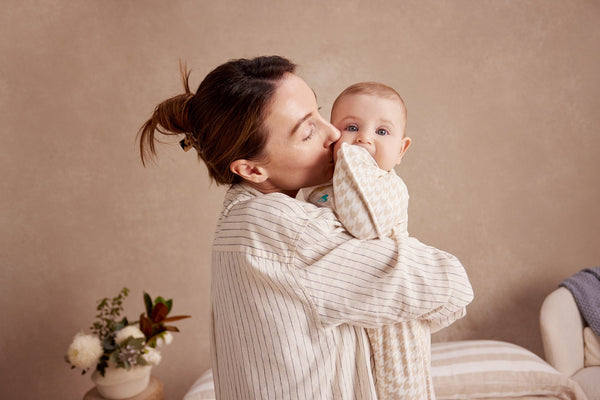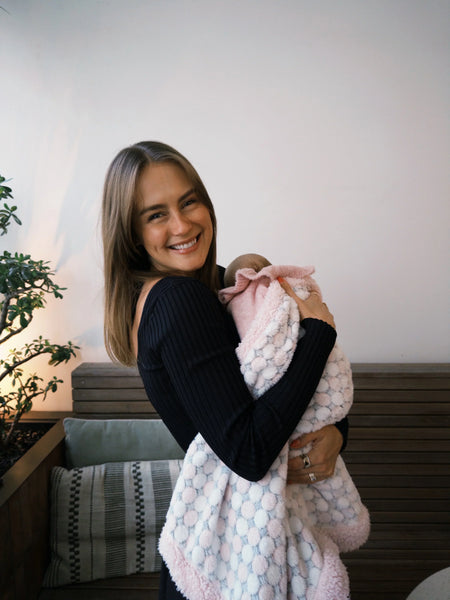How should I dress my baby for sleep?
At Love To Dream™, we’re here to guide you every step of the way. To dress your child safely for sleep, it’s important to consider the temperature of the room. Your little one should be dressed so they will stay comfortable during the night.
When selecting sleepwear for your baby:
-
Choose breathable garments and sleepwear. Our new Romper and PJ Collection is expertly designed to be layered with ease depending on the season and temperature to ensure your little one is comfortable during sleep.
-
Always ensure sleepwear is the correct size for your child’s age, height, and weight.
-
If you choose to swaddle your child, choose a swaddle that is made from a light, breathable fabric. Our award-winning Swaddle Up™ comes in a range of lightweight styles for different seasons and has a unique arms up™ design to enable your little one to self-soothe with ease. You must stop swaddling once your baby shows signs of rolling over.
-
Use our handy temperature guide to select the appropriate sleepwear for the temperature and climate.
Temperature:
When it comes to dressing your baby for sleep, there are a few things to consider: your baby’s room temperature, the climate, and whether there will be any fluctuations in temperature during the night.
If concerned, check your baby’s body temperature before you go to bed to ensure they are comfortable. To check whether your baby is too hot or too cold, feel their stomach or back, rather than their hands and feet.
Signs your child is overheating, may include:
- Crying.
- Flushed cheeks.
- Feeling clammy or sweaty to the touch.
If you notice your little one becoming too hot, reduce the number of layers or reduce the thermal grade of your sleep apparel. For further information, please find our safe sleep guidelines here.
What is a TOG?
When you see ‘TOG’ on a garment, it simply means: Thermal Overall Grade. The higher the number, the thicker the fabric. Our TOG rating guide offers a range of temperature-appropriate combinations and layering ideas for your baby.
Layers
Our award-winning rompers and pyjamas are designed for non-bulky layering with a range of styles to choose from depending on the season and the age of your child.
- For ages 0-18 months: The ideal clothing for sleep is a one-piece bodysuit (also known as baby onesies or rompers). Our rompers and bodysuits can be layered beneath Transition Bags or the Swaddle Up™ to prevent the need for loose blankets or clothing. With quick snap crotches and envelope necklines, nappy or garment changes are quick and easy.
- For 2-4 years old: Two-piece pyjamas give older children more independence when learning how to get dressed or use the potty. Our super soft and stretchy pyjamas provide comfort and breathability to help regulate your little one’s temperature during the night.
What should I dress my baby in underneath the Swaddle Up™?
Our bestselling Swaddle Up™ is made from a lightweight, breathable stretch cotton blend and comes in a range of styles for different temperatures. During the colder months, you can dress them in a full-length romper or bodysuit or bodysuit and leggings. During the warmer months, a sleeveless and legless bodysuit could be all that is needed under our Swaddle Up™.
Layering is ideal for changing temperatures as it allows you to easily remove a layer or two when required. You can find examples of how to dress your baby for sleep in our temperature guide.
What should I dress my child in underneath a Transition Suit or Transition Bag?
When your baby starts to show signs of pulling themselves up or trying to roll over (this usually happens at around six months), you must stop swaddling. Our Stage Two Transition Suits and Bags are designed to help your little one learn how to sleep more independently over time without losing the comfort that swaddling provides.
Rompers and bodysuits can sit snuggly underneath a Sleep Suit or Transition Bag with different styles to choose from according to the season. For the warmer months, we recommend sleeveless and legless styles. For the cooler months, long-sleeved rompers will provide more warmth.
What should my child wear for potty training?
Our two-piece pyjamas are designed to support children who are potty training or learning how to get dressed independently, as they can be pulled up and down with ease. They can also be worn for play, as some styles have gripped feet to prevent slipping.
How do I know what TOG rating is suitable?
A TOG rating is helpful when choosing your child’s sleepwear.
For the summer months, our new Romper and PJ Collection can be worn on its own or underneath a Swaddle Up™, Transition Bag or Transition Suit, depending on your child’s age and the temperature of the room.
How should I dress my child for sleep in summer?
During warmer seasons, choose a low TOG rating when purchasing a Swaddle Up™, Transition Bag or Suit. If your child needs more warmth, you can dress them in a short sleeve or sleeveless romper/bodysuit underneath.
With envelope necklines and twin zippers, our collection is designed to be layered and taken off with ease.
How should I dress my child for sleep in winter?
For the cooler months, you may choose to dress your child in a full-length romper, long sleeve pyjamas or a combination of romper and leggings. You may also choose to layer your child’s romper with a Transition Bag, Suit, or Swaddle Up™ depending on their age.
Use our handy temperature chart to select an appropriate layering combination for the temperature of the room.
Is there any clothing to avoid during sleep?
Always follow safe sleep guidelines. Babies regulate their body temperature through their face and head, never put your child to sleep wearing a hat, beanie or bonnet. Choose clothing that is the correct size for their age and in accordance with the temperature of the room.
Do not leave any loose layers, pillows, blankets or toys in their sleep space. Always put your child to sleep on their back with their face and head uncovered on a firm, flat, and clean mattress that is the correct size for the cot/bassinet.
You can learn more about safe sleep guidelines here or on the Red Nose Australia website.














